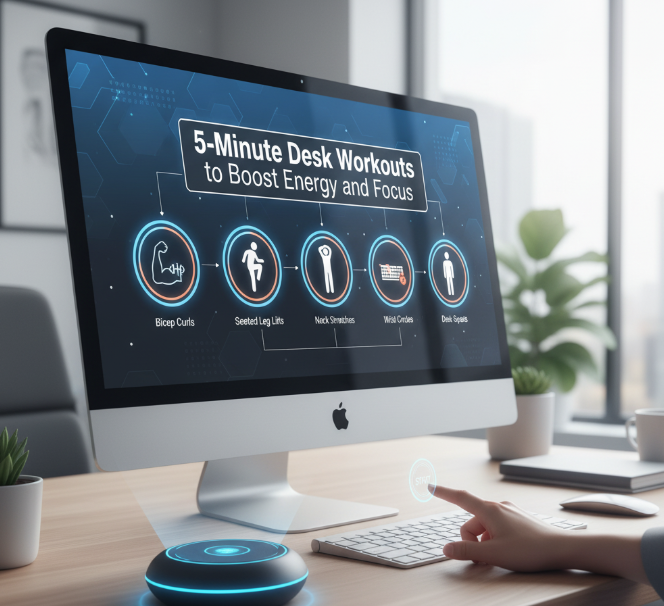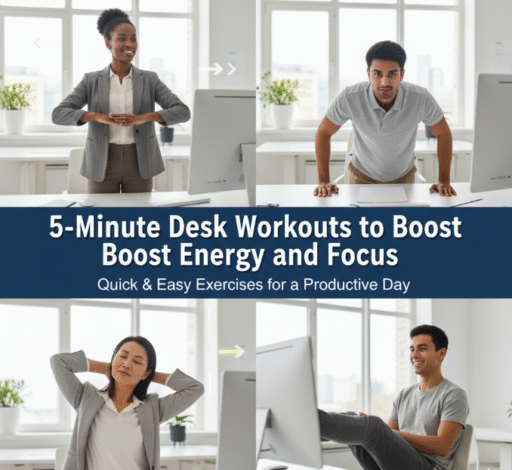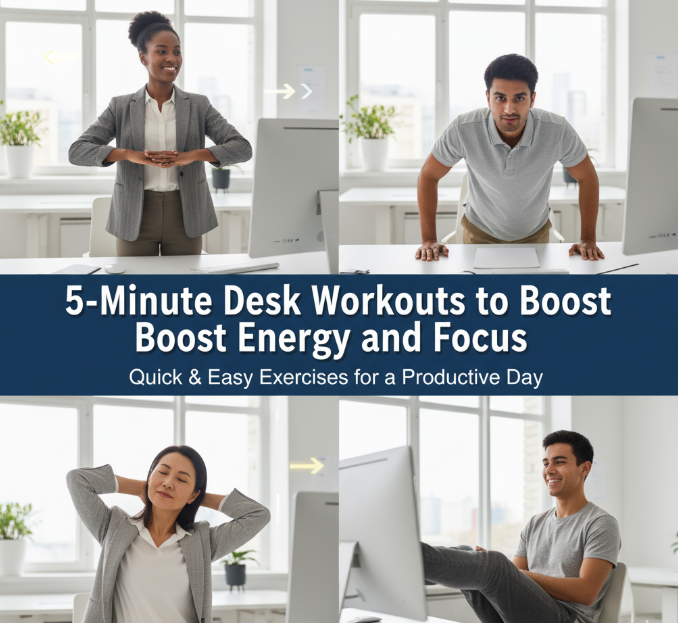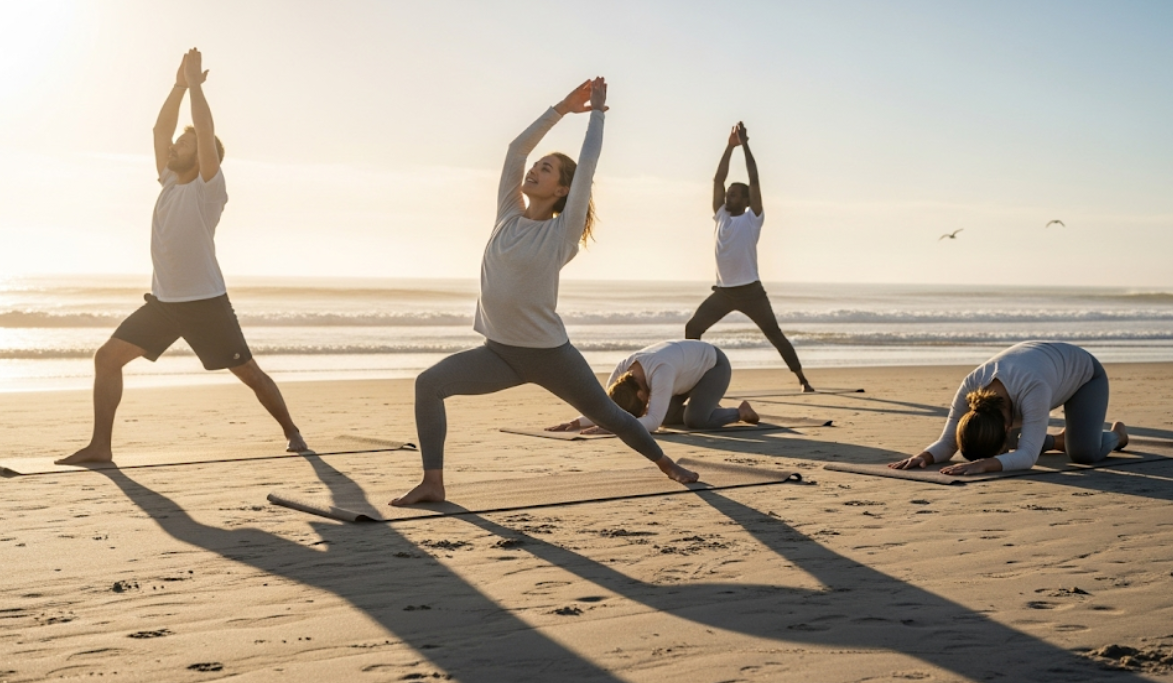Imagine this: It’s 2 p.m. on a Tuesday, and you’re looking at your computer screen. You feel heavy with your eyes, cloudy in your brain — and that third cup of coffee isn’t doing it for you anymore. You’ve got another three hours of work to go, but your body feels like it has already called it a day.
Sound familiar? You’re not alone. Millions work at desks, and our bodies just weren’t made for this. The typical office worker sits 10 hours a day, and all of that sitting doesn’t come cheap: low energy, lack of focus, back pain, and diminished productivity.
But, great news: You don’t need a gym membership or fancy equipment to turn things around. You can even keep working attire. In this episode, you’ll discover that in just five minutes with a tiny patch of space by your desk, you can fully recharge your energy and focus.
This article will teach you exactly how it’s done. We’ll discuss why sitting is energy-sapping (before you argue with me hear me out), which small exercises offer the most benefits and how to integrate these movements into your workday without adding any time or feeling too disruptive. Regardless of whether you are working from home or in a traditional office, these desk workouts will make you feel better, think clearer and get more done.
Why Your Desk Job Is Destroying You
Before we dive into the exercises, here’s what is actually going on with your body when you sit for long periods.
When you’re sedentary for long stretches, your blood flow slows. Your heart doesn’t have to work as fiercely and ends up pumping less oxygen-rich blood to your brain and muscles. This is why you feel sluggish and foggy, even if you have not physically done anything tiring.
Your metabolism also suffers a hit. Sitting for as little as 30 minutes straight can lead to a significant decrease in your metabolic rate, studies reveal. That means your body burns fewer calories and has less energy. It’s as though you’re shifting your body’s engine into neutral.
There is also the question of muscle tension. When you spend hours hunched over a keyboard, some of your muscles remain tight and others become elongated and weak. Your hip flexors contract, your shoulders hunch forward and your neck protrudes. This creates actual physical discomfort that your brain must continuously counter, siphoning off mental energy from the work you are supposed to perform.
Finally, sitting too much messes with your mood and stress levels. And exercise powers the release of endorphins — those brain chemicals that make you feel good and help keep stress at bay. When you sit all day, you’re deprived of these natural mood enhancers.
The answer is not to quit your job or stand all day (which brings its own set of problems). The answer is to break up extended sitting with short bursts of movement. It can even make quite an amazing difference in just five minutes.
The Science of Quick Body and Brain Exercise Breaks
Five minutes, you may be asking yourself, can five minutes make a difference? The research says yes—absolutely.
One study in the Journal of Occupational Health Psychology reported that workers who exercised on workdays had better perceptions of their own concentration, along with fewer mistakes and less physical discomfort. Another study from the University of Georgia found that just 10 minutes of light activity was a better energy booster than eating 50 milligrams of caffeine.
Here’s what happens in your body when you take a five-minute movement break:
Minutes 1-2: Your heart rate begins to speed up, sending more oxygen-rich blood throughout your body. Your brain then receives more oxygen, which readily enhances alertness and mental functioning.
Minutes 3-4: Your muscles will warm, and you’ll benefit as tension melts away. Our blood sugar gets mobilized for energy. Your body temperature rises a little, sending the signal to your brain that it’s time to get active and be alert.
Minute 5: Endorphins begin releasing. Stress hormones like cortisol begin to plummet. You rev up your metabolism and keep it up for as long as an hour after you stop.
The key is consistency. Just one five-minute workout will not change the trajectory of your entire day, but doing three or four such workouts over the course of your workday can help you to maintain a steady supply of energy and a healthy mind in an ache-free body.
Your 5-Minute Energy-Boosting Workout Plan
Now for the nitty-gritty. Here, then, is a full five-minute workout routine you can do while sitting at your desk. Every movement hits a different part of your body that aches from sitting stiff and tired all day. All you need is a chair and a few feet of space.
Exercise 1: Desk Push-Ups (45 seconds)
Do this while standing about three feet from your desk. Put your hands palms down on the edge of your desk and walk them out from shoulder-width apart. Step your feet back so that your body is in a straight line from head to heels. Lower your chest to the desk by bending your elbows, and then push back up.
This move wakes up your chest, shoulders and arms and helps you get that blood pumping. If standard desk push-ups are too easy, walk your feet further back. If all are too hard, it’s time to step closer to your desk.
Why it works: Push-ups target several large muscle groups at once, which requires more oxygen and blood flow. It’s quite an energy jack up.
Exercise 2: Chair Squats (45 seconds)
Place feet hip-width apart in front of your chair. Lower yourself as if you’re about to sit down, but just before your bottom hits the chair stop. Pause for a second, and then rise back into the starting position. Repeat continuously.
This movement recruits your legs, glutes and core — some of the largest muscles in your body. The larger your muscle group, the more your metabolism will be boosted.
Why it works: Your legs are home to huge muscles that require copious amounts of blood and oxygen when engaged. Squats push your heart to beat faster, giving you that burst of energy.
Exercise 3: Desk Shoulder Rolls and Arm Circles (30 seconds)
Roll your shoulders back in big circles 10 times, then forward 10 times. Then do arm circles: Reach arms out to your sides and make small circles (eventually widening). Do 15 forward circles, then 15 backward ones.
Why it works: Shoulder tension will restrict blood flow to your arms and neck. These movements help release that tension and increase circulation to your upper body and brain.
Exercise 4: Standing Knee Raises (45 seconds)
Stand with your chair to your back and hold the back for balance. Raise your right knee up toward your chest and lower it, then raise your left knee. Continue alternating, quickly shifting back and forth as if you’re marching in place.
Why it works: This move will get some movement through your hip flexors (which hi, otherwise they might be tight from sitting) while elevating your heart rate. It’s also a nice, gentle way to work your core.
Exercise 5: Desk Plank Hold (30 seconds)
If you’ve done push-ups, place your hands on your desk but stay there — freeze. Maintain a straight body, contract your abs and breathe evenly.
Why it works: Planks engage almost every muscle in your body all at the same time. They’re great for your core, strengthening other muscles as well and they involve focused breathing, which help to bring calm during a chaotic day while also recharging you.
Exercise 6: Spinal Twists (45 seconds)
Sit in a chair with your feet flat on the floor. Press your right hand against the outside of your left knee and your left hand on the back of your chair. Brace yourself, twist your torso gently to the left and look over your left shoulder. Stay for 3-5 breaths, then repeat on the other side. Repeat twice on each side.
Why it helps: Sitting squishes your spine and shortens the muscles in the back of your body. Twists decompress your spine and increase flexibility while relieving stress in your back muscles.
Putting It All Together
This is how your five minutes breaks down:
| Exercise | Time | Primary Benefits |
|---|---|---|
| Desk Push-Ups | 45 seconds | Upper body burn, cardiovascular jump |
| Chair Squats | 45 seconds | Leg strength, metabolism boost |
| Shoulder Rolls & Arm Circles | 30 seconds | Stress reduction, increased blood flow |
| Standing Knee Raises | 45 seconds | Hip mobility and heart rate increase |
| Desk Plank Hold | 30 seconds | Core activation to full-body work |
| Spinal Twists | 45 seconds | Backbone health with handling back tension |
| Total | 5 minutes | Complete workout reset! |
More Quick Exercises to Insert in Your Routine
Want to keep things fresh? Here are more desk-friendly exercises you can try instead:
Calf Raises (1 minute): Position yourself behind the chair for stability. Lift onto your toes, hold for two seconds and lower back down. This gets blood moving back from your legs to your heart and brain.
Wall Sits (30 seconds): Balance against a wall and slide down until your knees are at right angles, as if you’re sitting in an invisible chair. This is how you forge leg strength and mental fortitude.
Neck Stretches (1 minute): Slowly tilt your head to the right, hold for 10 seconds then repeat on the other side. Now, stare down at your desk for ten seconds and then slowly tip back your head. Forward head posture is one of the biggest desk job issues, and these stretches fix it.
Wrist Circles (30 seconds): Point your arms straight out in front of you and circle your wrists 10 times around one way, then switch; do it again. This can help avoid wrist pain and other common conditions such as carpal tunnel syndrome.
Standing Back Stretch (30 seconds): Stand, and clasp your hands behind your back. Lightly draw your arms back as you lift your breastbone forward, pressing your shoulder blades to each other. This is to counter the rounded-shoulder scenario from typing.
When to Do Your Desk Workouts
Timing matters. Here’s how to time your five-minute workouts for best effect:
Mid-Morning (10-11 AM): This is the time of the day that most people’s first wave of morning energy begins to wane. A fast workout will propel you seamlessly through to lunch without having to acquire extra coffee.
After Lunch (1-2 PM): Ok, so the post-lunch power nap is an actual thing. Your body shunts blood to your digestive system, giving less to your brain. You’ll move the blood off the sandbag, and you’ll beat that afternoon slump.
Mid-Afternoon (3-4 PM): By the numbers, this is actually the lowest energy time during most peoples’ workday. A five-minute workout here can be the difference between productive final hours and staring at the clock.
Optional Fourth Session: If you’re working late or have an evening deadline, doing one more quick session around 5-6 PM can take you to the finish line.
The magic is less in how hard you work and more in doing it consistently. Three days a week it is better to take gentle movements than do an intense workout one day and then nothing for the next three days.
Creating Your Desk Workout Habit
It is one thing to know what to do. Actually doing it is another. Here’s how to turn desk workouts into a permanent part of your routine.
Use Phone Reminders: Most of us forget to take breaks because we are engrossed in work. Three alarms on your phone for times you’ve chosen to work out. Call them something inspirational like “Energy Boost Time!” or “Brain Break.”
Begin With One: You’re not doing three workouts on day one. Begin with a single five-minute session for the first week. Do it a second time, and when that is automatic, add a third session.
Attach it to current habits: Combine your workout with something you already do. Such as: “As soon as I’m done with my morning emails, I’ll do a desk workout.” This is what’s known as habit stacking, and it is one of the most effective behavior change strategies out there.
Track Your Streak: Take a calendar and mark an X on each day you do your workout. Seeing a string of X’s fuels the motivation to keep the streak alive.
Make It Social: At the office? Ask some coworkers along. Accountability partners make it likelier that you’ll follow through x10. Plus, it’s more fun together.
Adjust as Necessary: There will be days you have back to back meetings or pressing final deadlines. That’s okay. If you can only fit in one session instead of three, that’s still something. Do not let the perfect be the enemy of the good.
Here’s What You’ll See After a Week
Folks who begin regularly working out at their desk tend to see these positive changes in only one week’s time:
Increased Afternoon Energy: The 2-3 PM crash is less intense or gone completely. You will be more consistently energetic all day.
More Focus: You’re less susceptible to distractions. You’ll find yourself getting pulled off of attention less frequently and finishing things faster.
Discomfort Diminishes: Suddenly, the persistent backache and neck-knot resting on your shoulder begin to feel better. You make your desk more comfortable to sit at.
Mood Booster: Endorphins are released when you exercise that also decrease stress going forward. You are also probably going to find yourself feeling calmer and more positive during the workday.
Better Posture: All that moving around helps your body remember what good posture feels like. Now you’ll start to sit up straighter — automatically.
At the end of one month of regular desk workouts, these advantages are even more evident. Many people speak of sleeping better, feeling more motivated and are able to be far more productive at work.
Typical Barriers and Effective Strategies to Get Around Them
Okay, let’s get the standard desk-training caveats out of the way:
“I’m going to look pretty weird when I do this in an office.” Begin with the more gentle exercises, including seated twists and shoulder rolls. Or locate a private space, like a conference room or stairwell. But most importantly, don’t be ashamed of taking care of your health.
“I don’t even have five minutes.” You have time for what you value. Give this a thought: Which one do you prefer, 5-minute exercising or 30-minute unproductivity, because you are tired and feeling unfocused? This workout saves you time by making your work time more efficient, in fact.
“I’m too tired to exercise.” That makes sense, only it’s backwards. Physical activity makes you have more energy, not less (unless we’re talking about seriously intense training here — and desk exercise will not count as such). The moments when you are too tired to stop and take a walk through the trees is when you need it most.
“My coworkers might judge me.” In practically everyone’s life, no one is paying attention to you and your work as much as you are. And if they do see you wearing one, chances are they’ll be more impressed by your commitment to good health than inclined to judge.
“I forget to do it.” This is the top barrier. Solution: Create habit loops (like phone alarms, calendar blocks, post-it notes) to remind you of the behavior.

Beyond the Basics: Lifestyle Habits That Support Energy & Focus
Workouts you can do at your desk are great, but become even greater when supported by these habits:
Hydrate: Fatigue and brain fog are two of the symptoms of dehydration. Keep a water bottle by your desk and go for 8 glasses of the stuff over the course of your day.
Optimize Your Workspace: Elevate your monitor to eye level, keep your keyboard within reach so that you don’t extend your arms at an angle greater than 90 degrees and, ideally, ensure that the chair in which you sit for hours on end has lumbar support. Learn more about ergonomic workspace setup to prevent long-term issues.
Take Actual Breaks: Besides your exercise breaks, try to give yourself at least a few minutes every hour look away from the screen and rest your eyes.
Smart Snacks: Resist the vending machine. Stock up on healthful snacks at your desk — nuts, fruit, vegetables or protein bars. Sugar crashes make the afternoon slump even worse.
Step Into the Morning Sun: Take 10-15 minutes to stand or sit outside in daylight each morning. It controls your body’s internal clock and make your day-time energy better.
Get Enough Sleep: A few desk exercises cannot replace ongoing sleep deprivation. Aim for 7-9 hours per night.
Frequently Asked Questions
Is it okay to do these exercises if I’ve been experiencing back pain?
Yes, but with caution. In fact, most of these core strengtheners can actually help alleviate back pain by improving posture and strengthening supporting muscles. But if any of this movement feels painfully sharp, cease it and see a doctor right away. You may have to adjust some of the exercises — say, performing wall push-ups instead of desk push-ups if desk push-ups hurt your back.
Can I really make a difference by adding even just five minutes, or do I need to work out longer?
Five minutes here does indeed add up when you do it over and over again all day long. There is research to suggest that, in fact, taking several short movement breaks can be more effective than just one long workout at keeping your energy up and your brain focused. That said, like these desk workouts are designed to complement—not be a substitute for—your standard fitness routine. The goal is about 30 minutes of moderate activity most days of the week for general health.
How fast can I expect to feel more energized as a result of performing these exercises?
Many people report feeling an immediate surge of energy and alertness after their desk workout. The benefits are usually felt for 1-2 hours and that’s why doing them 3-4 times throughout the day avoids highs and lows.
What if I work from home and don’t have a traditional desk?
These exercises work anywhere. Use a kitchen counter instead of a desk for push-ups, grab hold of the back of a sturdy chair for squats, and find any wall that will work for stretches. The tenets are the same wherever you work.
Can I do these every day?
Absolutely. These are less intensive exercises meant for everyday use. While you really need a day or two of recovery after an intense gym workout, gentle desk exercises can and should be done every workday.
Will my colleagues think I am weird?
Probably not. It’s more than ever natural to be health conscious at work. It’s worth noting that some forward-thinking companies not only don’t mind your movement breaks, but encourage them. If you are worried, begin with seated exercises or retreat to a private space. Heck, you might even inspire others to join in.
What if I’m in meetings back to back all day?
Try to add 5-minute buffers between meetings just for movement breaks. And if that’s not possible, do whatever you can — 2-3 minutes of stretching and shoulder rolls between calls really does make a difference. You can also squeeze in some unobtrusive exercises while on video calls if your camera only displays the upper half of your body, such as seated leg raises or ankle circles.
Do I need any equipment?
No equipment necessary. Your desk, your chair, and the weight of your body is all you need. That’s what makes desk exercise accessible and easy to do for anyone.
Is weight loss possible with these exercises?
Although they do burn some calories and increase metabolism, desk workouts are nowhere near intense enough for the latter on their own. But they can help with weight management by creating a net increase in your daily activity, revving up metabolism and reducing stress-induced eating. To help with weight loss add desk workouts to your regular fitness routine and a clean diet.
How do I stay motivated to continue doing this over the long haul?
Track your progress and results. Keep a basic record of how you are feeling before and after your workouts. You should feel increased energy, focus, and comfort. These are positive reinforcements that will help keep you going. Also, keep in mind that habits typically take around 2-3 weeks before they start to feel a bit more automatic. Power through those first few weeks and it gets a lot easier.
Your Action Plan: Starting Tomorrow
And now that you have everything you need to change up your workday energy and focus. Here’s your simple action plan:
Today: Reread the exercises one more time. Bookmark this article or jot down the workout order where you see it.
Tomorrow Morning: Build a mountain of phone alarms for your intended workout time. Have your first five-minute workout at your mid-morning alarm.
Rest of Week One: Concentrate on that one mid-morning workout only. Make the exercises second nature and part of your routine.
Week Two: Add your second workout session (ideal would be post-lunch time).
Week Three: Add your third workout session (mid-afternoon). Notice how much better you feel than three weeks ago.
Week Four: Keep going. As needed: adjusting timing, incorporating other types of exercises for novelty, and enjoying the newfound energy and connectedness.
The Bottom Line
No one said sitting at a desk all day must mean feeling drained, unfocused and uncomfortable. Your body is built to move, and it will repay you richly when you supply it with what it craves — even in tiny increments.
Five minutes is not very much time. You likely spend longer than that scrolling through social media or refilling your coffee. But those five minutes of deliberate motion can totally transform the way you feel and function at work.
The workouts in this article are straightforward and non-device-based, easily done anywhere. They are supported by sound science and proven effective from masses of people who have incorporated them into their daily life.
You don’t have to be fit or athletic to begin. No one is required to grant you permission, not your boss, not your coworkers. You just need to start.
So the next time you have a bout of that mid afternoon energy drop, or your focus begins to fade, don’t hit up another cup of coffee or energy drink. Instead, get off your behind and move your body for five minutes with these simple exercises and feel the difference.
Your body will thank you. Your brain will thank you. And your productivity will skyrocket.
The only thing left to ask is: When will you begin?






